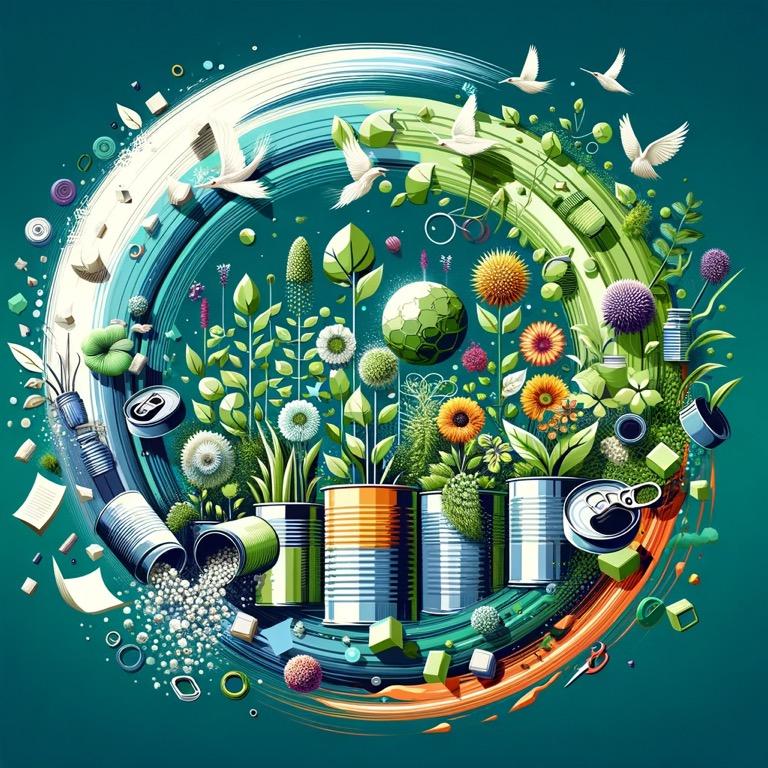
In the vibrant city of Austin, Texas, Bryce had an idea that sprouted from a love for gardening and a passion for sustainability. Bryce began his journey by growing microgreens and wildflower seeds from the Lady Bird Johnson Wildflower Center. Using upcycled aluminum cans and household paper, Bryce transformed waste into thriving planters, each carefully tracked with Life Story Data.
The Birth of an Eco-Friendly Garden
Bryce and his partner Natalie were always conscious about their waste footprint. Their household produced a steady stream of recyclable materials—cans and paper—that Bryce saw as untapped resources. With a bit of creativity, Bryce began converting these materials into self-watering planters.
He filled the planters with nutrient-rich soil and carefully sowed microgreens and wildflower seeds. Each planter was labeled and tracked using Life Story Data, allowing Bryce to monitor the growth and health of his plants. For microgreens, the cans had enough water to sustain the entire growing cycle, making them extremely low-maintenance and ideal for busy urban gardeners.
Sharing the Greenery
Bryce’s home soon became a green oasis, filled with flourishing microgreens and colorful wildflowers. But the joy of seeing waste turn into something beautiful and life-sustaining was something he wanted to share. Bryce began giving away these upcycled planters to friends and neighbors, spreading the green revolution one can at a time.
Word of Bryce's innovative planters quickly spread, and the demand for these eco-friendly growing vessels grew. Recognizing the potential to make a larger impact, Bryce decided to offer this service to other households and businesses.
Building a Cooperative
To manage the growing demand, Bryce formed a cooperative. The cooperative model allowed for a community-based approach, where members could subscribe to the upcycling service. For each subscription, the nearest cooperative member would perform the labor of collecting, processing, and converting waste into planters. This model ensured that the service was efficient, localized, and had minimal environmental impact.
The cooperative members, driven by a shared passion for sustainability, worked tirelessly to upcycle waste into valuable planters. Households and businesses alike embraced the service, delighted to see their waste transformed into something beautiful and functional.
Artistic Flourishes and Community Engagement
Beyond the home gardens, artists began to see the potential in Bryce’s modular growing cans. They started using these upcycled planters as living pixels, creating wondrous temporary exhibitions at Austin music festivals. These installations became a highlight, with fans encouraged to take home as many planters as they could carry. The microgreens provided free snacks for the journey home, further spreading the message of sustainability and community involvement.
A Circular Economy Takes Root
Within a few months, Bryce’s initiative had blossomed into a robust circular economy. The cooperative's efforts significantly reduced waste, and the upcycled planters became a common sight in homes, offices, and community gardens across Austin. This grassroots movement fostered a sense of community and shared responsibility for the environment.
The success of the initiative in Austin inspired other cities to adopt similar models. The concept of upcycling waste into thriving planters resonated with people everywhere, leading to a broader movement that extended beyond Austin’s borders. Bryce's vision of a greener, more sustainable future was becoming a reality, one upcycled can at a time.
Conclusion
Bryce’s journey from growing microgreens and wildflowers to transforming waste into a community resource exemplifies the power of innovation and community spirit. By turning recyclable materials into self-watering planters, he not only beautified his surroundings but also fostered a sustainable, circular economy that benefits everyone involved. As the cooperative continues to grow, so does the promise of a greener, more sustainable future for communities far and wide.